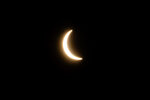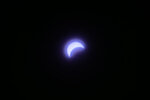NASA describes the eclipse as "an awe-inspiring celestial event that drastically changes the appearance of the two biggest objects we see in our sky, the sun and moon."
The events …
This item is available in full to subscribers.
We have recently launched a new and improved website. To continue reading, you will need to either log into your subscriber account, or purchase a new subscription.
If you had a login with the previous version of our e-edition, then you already have a login here. You just need to reset your password by clicking here.
If you are a current print subscriber, you can set up a free website account by clicking here.
Otherwise, click here to view your options for subscribing.
Please log in to continue |
|






NASA describes the eclipse as "an awe-inspiring celestial event that drastically changes the appearance of the two biggest objects we see in our sky, the sun and moon."
The events occur every one to three years somewhere in the world. The last eclipse we saw was only partial, about 70 percent, in 2017.
The next solar eclipse won’t be visible again from the United States until August 2044. However, totality will only occur over North Dakota and Montana. The next total solar eclipse viewable from coast to coast will occur in 2045.
Comments
No comments on this item Please log in to comment by clicking here